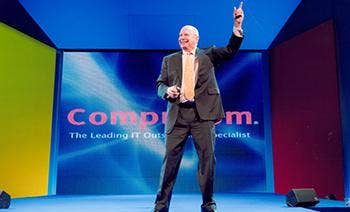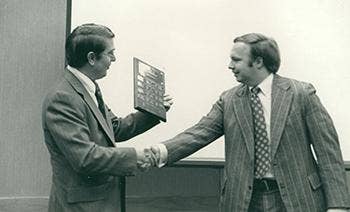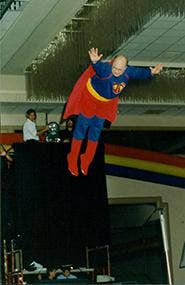IT Hall Of Fame: How Jim Dixon Put Customers First And Turned CompuCom Into A Services Giant

Every so often, Jim Dixon looks up a list on his phone labeled "competitors."
On that list appear 22 major companies such as MicroAge and Businessland that Dixon competed against during his early years as CEO of Plano, Texas-based CompuCom. Every single one of those companies is out of business.
Except for CompuCom.
Under Dixon's leadership from 1988 to 1996 and again from 2004 to 2013, CompuCom evolved from selling PCs in retail stores into a $2.2 billion behemoth that derived more than half of its revenue and three-quarters of its gross margins from IT outsourcing and services.
Dixon is being honored Tuesday night at the XChange 2016 conference with an induction into the IT Hall of Fame, which was founded by CRN in 1997 and has been administered by CompTIA since 2010.
[Related: How CEO Jim Dixon Turned CompuCom Around From The Brink Of Disaster]
"Jim continued to evolve with the industry," said Robert Faletra, CEO of CRN parent The Channel Company, which hosts XChange. "He did it largely by focusing on what the customer's needs were and moving the business as the industry moved."
So why was Dixon able to transform CompuCom's business from PCs to network integration to recurring revenue services while so many of its peers withered away?
Chalk that up to a conservative cost structure, tight-knit client relationships that involved actual listening rather than just selling, and fiercely loyal employees, Dixon said.
"The customers tell you where to go," Dixon told CRN. "The industry and the competitors tell you where your costs ought to be."
Dixon rose up the ranks in IBM's sales group during his 14 years at Big Blue before leaving for a senior leadership role at a small company. The CEO of that small firm called Dixon in one day, accused him of not doing anything in his first two months on the job, and asked how Dixon planned to save the company money.

Dixon presented his proposals to the CEO on a Thursday night, and the CEO told Dixon to bring the guys in that Saturday to begin implementing the plans. But there was one problem: The next day was Easter Sunday, and Dixon didn't feel that was the right time to do it since some of the employees already had plans for the holiday.
"And he told me, 'Easter, my ass. My mother died, and I didn't go to the funeral. I had a business meeting that day,'" recalled Dixon. "I left that company, obviously -- I left the next day."
From that point forward, Dixon vowed that he would institute strong, IBM-style core values once he was running his own company. And when Dixon took the reins at CompuCom a few years later, his executive team developed four core values that have appeared on the back of every company business card for nearly three decades: "win/win, integrity, respect for the individual, and excellence in everything we do."
"The definition of a core value is something you believe all the way down to your toes," Dixon said. "If the economy is bad and your business is bad, your core values still hold."
Respect for the individual often takes the form of service in Dixon's world, which is why he's cooked between 35,000 and 40,000 shrimp for CompuCom's employees during his CEO tenure. When Dixon was visiting staff around the country, he would FedEx in shrimp from Louisiana Seafood, fly in an 80-quart pot, rent a city park and prepare a Cajun-style meal complete with red potatoes and corn on the cob.
"They gave me a little credit when I cooked for them," Dixon said. "But they gave me a lot of credit when I cleaned the pots."
Dixon too got something out of these cookouts; inevitably some employees would ask to speak with him in private about problems they felt he should be aware of. In that way, Dixon said the cookouts created an opening for him to figure out what was really going on at the company.
"That respect he gives to somebody five levels below him in the organization is disarming," said Ed Anderson, who was CompuCom's CEO from 1993 to 1999 and chief strategy officer from 2009 to 2013. Dixon inspired such loyalty that employees would "run through a fire" for him, Anderson said.
That's reflected in CompuCom's inverted organization chart, which put the customer at the very top, followed by the salespeople and technicians that directly interface with the customer. Directors and vice presidents appeared further down the chart and, as CEO, Dixon appeared at the very bottom.
Account executives were fined $5 if a customer asked about an organizational chart during a sales briefing and the rep started by pointing out the CEO rather than pointing out the customer and the rank-and-file employees. Dixon said the inverted org chart helped reinforce that the most important people in an organization are those actually touching the customer.

"My job was to make our people happy, and our people kept our customers happy," Dixon said.
As part of Dixon's effort to keep employees happy, CompuCom would often hold large staff roundtables. One such roundtable, Anderson said, took place with a few hundred IT support and call center employees in Houston in the wake of the tough 2008 recession.
"After about 10 or 15 questions, one woman raised her hand in the back row and said, 'I've been three years without a raise. Where's my goddamned raise?'" Anderson recalled.
Dixon navigated the sticky situation with aplomb, making the woman feel good not by giving her a raise, but instead by explaining that the company's intent was in the right place. In fact, the woman was so impressed by how Dixon handled her question that she shared the story with Anderson six months later.
"He will listen to people in a way that makes them feel comfortable in an awkward moment," Anderson said. "When you look somebody in the eye and give them respect, they care more."
That respect for ordinary employees came across in the most routine of affairs. When Anderson and Dixon visited client sites for meetings, Anderson said Dixon would regularly walk over to the receptionist in the waiting area, stick out his hand and introduce himself.
"The receptionists would later tell me, 'That's the first person from corporate than ever did that,'" said Anderson, noting that Dixon also excelled at remembering people's names. "He was really good at the stuff that everybody else takes for granted."
Dixon's unassuming nature, lack of pretension, Southern charm and reputation as a straight shooter made him a great salesman and popular manager, said The Channel Company's Faletra.
"People want to buy from people they like," Faletra said. "He could talk to the garage mechanic or he could talk to the president of the United States, and do it all really well."
During Dixon's first stint as CEO, CompuCom maintained the lowest cost in the industry by consolidating inventory and order entry from dozens of branches nationwide to a single centralized location, and eventually going branchless, with technicians working from the depot and sales reps working from home.

Dixon was adamant that low overhead was essential to surviving in the world of commodity selling, and provided CompuCom with a buffer should it miss a technological trend or development by a year.
"I can't always say we moved faster than everybody else, but we had a cost structure to say if we missed it by a little bit, we could still survive," Dixon said.
CompuCom under Dixon tended to be fast followers, Anderson said, and shied away from going all in on the latest fad until Dixon fully understood the disruption taking place and the opportunity arising from it. Dixon was a thoughtful leader, Anderson said, and truly wanted to internalize how the business would need to move to succeed in a new arena.
"Jim instinctively is not the first mover," Anderson said. "He didn’t want to be the first one to get arrows in his back."
The best executives, Dixon said, spend an ample amount of time simply listening to their customers.
"You're not trying to sell them something," Dixon said. "You're figuring out their problems, where they're going and why."
After listening to enough customers, Dixon said CompuCom could begin building a trend line and understanding where it needed to be.
"Everybody thinks great salespeople are great talkers," Anderson said. "But Jim's a better listener than he is a talker."
Dixon not only listened to his customers to gain a better understanding of where the industry was heading, Anderson said, but was also very open to feedback within his own company.
Given his background in sales, Anderson said Dixon didn't necessarily know which knobs had to be turned or which levers had to be pushed or pulled to excel in a new technology area, but he excelled at asking detailed questions of his technicians that often uncovered issues they hadn't even thought of.
Dixon told CompuCom's new private equity owners in 2004 that he would return as CEO only if they agreed to build a services business. Dixon's work consulting for a private equity group in the early 2000s allowed him to see with his own eyes that the highest gross margins were being earned by the companies offering the most recurring revenue-based services.
"I saw who was profitable and who wasn't profitable, and I saw why," Dixon said. "If you didn't move to services, you couldn't make the profits you needed."
Under Dixon, CompuCom become one of the first major solution providers to lead with services and have them drag hardware sales rather than the other way around, said Frank Vitagliano, Dell's vice president of North American channels and vice chair of CompTIA's board of directors.
Specifically, Dixon understood that VARs had become too dependent on using rebates to drive product sales and realized that companies like CompuCom needed a business model that was more in tune with customers' business requirements than speeds and feeds, Vitagliano said.
"Jim was a visionary there, and he was on the forefront of that," Vitagliano said. "He ought to be proud of himself."
Transitioning from a 60- to 90-day sales cycle in the transactional hardware business to a four- to seven-month services sales cycle proved difficult for many reps, Dixon said, and just 10 of CompuCom's 110 sales reps at the time were able to master both hardware-focused transaction sales and services-focused solution sales. So CompuCom ended up hiring a lot of new people to drive services sales, Dixon said.
"Services are different, and you need a specialized sales force for the majority of it," Dixon said.
That strategy paid dividends, as CompuCom's IT outsourcing services revenue during Dixon's second run as CEO grew from $220 million to $1.1 billion, while the share of overall revenue coming from hardware plummeted from 90 percent at the start of Dixon's second term to just 40 percent by the end of it.
Dixon set the tone for his second run as CEO in his third day on the job when he restored the Starbucks service taken away by the private equity owners in a cost-cutting move.
The lack of Starbucks was the single biggest complaint Dixon heard upon returning to CompuCom, and Dixon figured that anything that could create such happiness for just $50,000 to $100,000 each year was money well spent.
Ultimately, Faletra said Dixon truly understood that CompuCom's most important asset wasn't the name on the building or even its business plan, but rather all the people that worked for him.
"You can be really successful, make tough decisions, and still be a good guy," Faletra said.